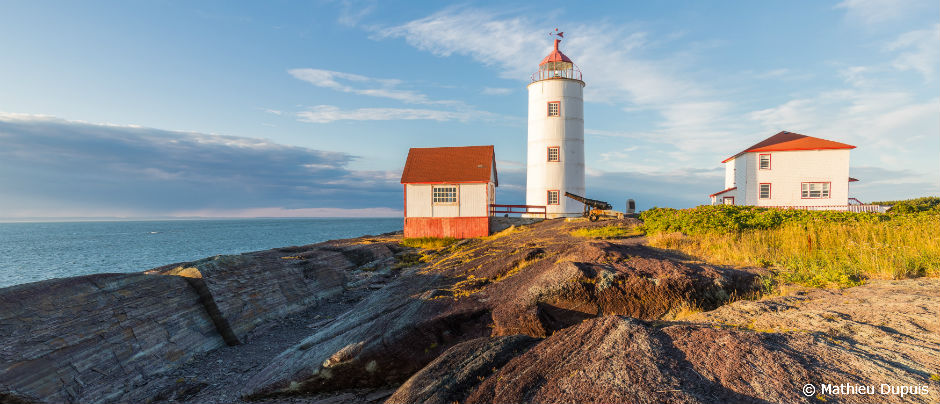The Québec maritime Blog

-
Île Verte Lighthouse
Mathieu Dupuis
7 Lighthouses, 7 Unique Histories
Built along the St. Lawrence, the lighthouses of Québec by the Sea have witnessed major events in maritime history. They have held steadfast over the years and during storms, guiding crews through fog and darkness. Each lighthouse has its own special history. The seven described here promise visitors a truly memorable experience!
Witness to Canada’s worst maritime tragedy

On the night of May 29, 1914, the Empress of Ireland was struck by a Norwegian coal ship, the Storstad, near Pointe-au-Père in Bas-Saint-Laurent. The ship was headed for Liverpool and sank in just 14 minutes, killing 1012 of the 1477 people on board. A 128-step climb to the top of the Pointe-au-Père Lighthouse (the second tallest in Canada) provides a clear view of the waters where this terrible tragedy occurred. The Empress of Ireland Museum, located behind the lighthouse, recreates the ship’s last voyage.
Oldest in Québec

The Île Verte Lighthouse dates back to 1809. It was the very first to be built along the St. Lawrence and is the third oldest in Canada! Its construction is a testament to the expansion of trade and navigation during that era. To discover the history of the lighthouse, travel to Île Verte in Bas-Saint-Laurent and stay in one of the lightkeepers’ homes, which have retained their old-world charm. Let the sound of the waves lull you to sleep beneath the welcoming beacon as it sweeps across the waters.
Tallest in Canada

The sheer height of the Cap-des-Rosiers Lighthouse is striking. Located near Forillon National Park in Gaspésie, the lighthouse is an important symbol for the region and is of great heritage value due to its location, design and construction. Climb the 122 steps to the top for a spectacular view of the Gulf of St. Lawrence and marine mammals. The lighthouse is still in operation today, guiding boaters and inshore fishers to safety.
A travelling lighthouse
Pointe-à-la-Renommée Lighthouse

The Pointe-à-la-Renommée Historic Site is located further north along the Gaspé Peninsula, on Route 132. There is much to take in here! The first lighthouse was built on this site in 1880 after many shipwrecks had occurred. (It was replaced in 1907.) The lighthouse was home to Canada’s first wireless telegraph system, installed in 1904. You can learn more about this national historic event by visiting the exhibit “Marconi and the Story of Radio Communications.” By 1977, the structure had been abandoned and was moved to the Port of Québec (in Québec City). Following a concerted effort by the community, the lighthouse was brought back home to its original location 20 years later, which is why it is nicknamed “the travelling lighthouse.” The structure was then opened to the public.
Original timing system

You can’t miss the bright-red octagonal wooden structure of the La Martre Lighthouse as you drive along Route 132. Visitors can stop to admire it from up close and learn how the light rotates using the original timing system. An exhibit showcases the technical evolution of the lighthouse and the history of two shipwrecks that occurred nearby.
Home to a famous naturalist

The Île aux Perroquets Light Station has a charming history. The island is located in the Mingan Archipelago National Park Reserve in Côte-Nord, and the lighthouse was built in 1888. The first lightkeeper was Henry de Puyjalon, a French naturalist who left his mark on the region through his explorations of northern Québec’s wilderness. Visitors can follow his footsteps and spend the night on the island—both the lightkeeper’s and the assistant lightkeeper’s homes have been restored and transformed into four-star inns! Guests will learn how lightkeepers lived. You can also book an excursion to observe the famous Atlantic puffins, known as “sea parrots,” which the island is named for.
A seabird sanctuary

This lighthouse is very well known in the Îles de la Madeleine and stands watch over the famous Rocher aux Oiseaux (Bird Rock), a sanctuary for several species of seabirds. Though the lighthouse is not open to the public, you can admire it during a boat excursion, along with northern gannets, razorbills and black-legged kittiwakes. The minute you see the red sandstone you will understand why Rocher aux Oiseaux needed a lighthouse! It warned sailors of this huge rock lying in the middle of the Gulf of St. Lawrence. It is the only remaining operational lighthouse in the Îles de la Madeleine.
Are you a maritime history buff? To learn more about these majestic sentinels of the sea, follow the Lighthouse Trail during your next visit to our regions!

(0) comment